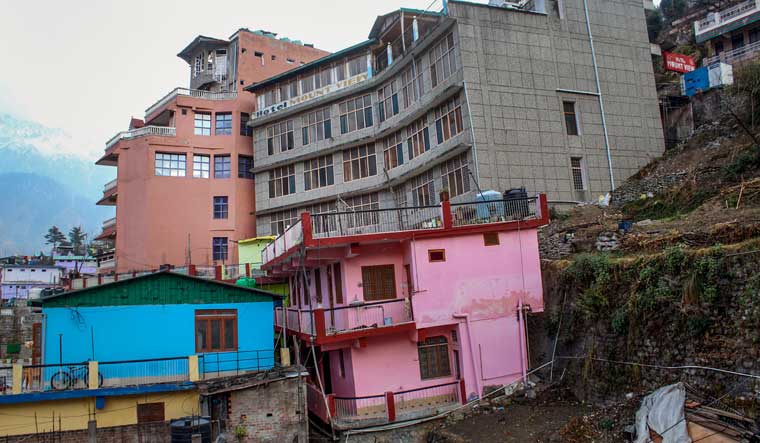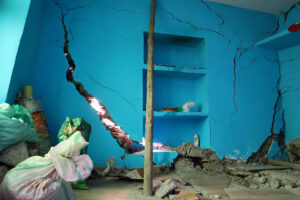Rethinking Infrastructure Development In The Himalayas
Dec 26, 2023 | Pratirodh Bureau
FILE PHOTO: Some buildings affected by the land subsidence in Joshimath, Uttarakhand (Image: PTI)
- The Himalayan region has seen several extreme weather events and disasters this year.
- Experts have repeatedly raised concern about the carrying capacity of the fragile Himalayan terrain and the need for caution while developing infrastructure.
- The infrastructure development strategy for the Himalayas should take into consideration the vulnerability of the region and the need for environment protection, writes the author of this commentary.
Despite repeated warnings from geologists and environmentalists about the fragile status of the Himalayas and the need for utmost caution while constructing dams, roads, power plants or tunnels, haphazard construction for energy, increased revenue from tourism and pilgrimages continue unabated.

The collapse of the under-construction Silkyara tunnel on the Brahmkhal-Yamunotri highway in Uttarakhand is the latest in the chain of disasters that almost killed 41 workers who were trapped in it for 17 days from November 12. Were geologists or engineers overseeing the construction of the tunnel? Manish Khalko, the managing director of the National Highways and Infrastructure Development Corporation Ltd, said the falling of the debris in the under-construction tunnel was a recurring feature but no one expected it would be severe enough to trap the workers inside. While it is true that the rescue of the workers was a Herculean task deserving all praise, the questions to be asked are: Why did the tunnel collapse? Was the fragility of the mountain system kept in mind while digging the long tunnel through the heart of the mountainous region? Was it preventable?
A Ticking Time Bomb
In fact, with the steady decimation of forests, torrential rains and landslides becoming chronic, the government needs to relook at all its projects in the Himalayas and this includes the Char Dham Yatra route, the power projects and road widening for increased traffic. Eminent ecologist Madhav Gadgil and environmental activist Sunita Narain of the Centre for Science and Environment had warned a decade ago about over-development as a ticking time bomb.
Gadgil, in his autobiographical book, A Walk Up The Hill, highlights the tremendous environmental destruction taking place across the country. He refers to the degradation of forests of Uttarakhand and the habitat of the goral and other wildlife, triggering the landslide of Chamoli in 2021 and the death of 204 people.
Way back in July 2013, Sunita Narain, in a column, pointed out that extreme rain events have become frequent. On June 16, 2013, it rained without a break and some 200 mm came down within hours in a few places like Kedarnath. It brought down the mighty Himalayas. Villages were wiped out, property destroyed, roads washed away and hydro power projects damaged in Uttarakhand. “The mountains are bleeding and its people have been left battered, bruised and dead,” she wrote.
Experts have repeatedly raised concern about the carrying capacity of this terrain and the slope cutting activities defying geological wisdom. The development strategy for the Himalayas should take into consideration the vulnerability of the region and the need for environment protection.
Sinking Joshimath And Pilgrim Centres
The 1976 government-appointed M. C. Mishra (Collector of Garhwal) Commission report as well as the 2006 report of the Wadia Institute of Himalayan Geology had warned against construction activity in the Himalayan region and more so in and around Joshimath. Mishra’s report pointed out that Joshimath was on a deposit of sand and stone and not rock and the rivers Alaknanda and Dhauli Ganga could trigger landslides. Yet, tunnels are being blasted in the seismic zone, putting the town in great danger. Roads and other infrastructure are being proposed and dams have been built upstream. It is clear that this region cannot take anymore.
So, on January 6 this year when news broke of Joshimath sinking, it shocked the world but not the people of Joshimath or the experts who had been warning of the fragility of the region. As the cracks in buildings and hotels became larger, there was an exodus. Some 4000 people had to abandon their homes and seek shelter in relief camps and negotiate for compensation. Reports of land subsidence poured in from other hill towns such as Karnaprayag, Uttarkashi, Guptkashi, Rishikesh, Nainital and Mussoorie.
The number of visitors to the holy town of Joshimath are said to have doubled from 2.4 lakhs in 2017 to 4.9 lakhs in 2019. The pilgrim pressure to Badrinath, Kedarnath, Yamunotri and Gangotri seeking inner peace has put stress on the carrying capacity of the region. The Char Dam Yatra Project of 2016 is one of largest road widening projects of the region and seeks to convert the 889 km road linking the four holy cities from 5 metres to 10 metres. Simultaneously, housing facilities were to be increased to accommodate the pilgrims. A yatra that was once undertaken on foot is now a highway pilgrimage.
In addition, the bursting of an underground aquifer during the construction of a tunnel of the 520 mw Tapovan-Vishnugad hydropower project added to the stress of Joshimath. Satellite images released by ISRO’s National Remote Sensing Centre showed that the town sank by 5.4 centimetres between December 27, 2022 and January 8, 2023.
In February this year, Ravi Chopra, who headed a committee formed by the Supreme Court to examine the concerns raised on the Char Dham project, resigned disappointed on the court ignoring the panel’s advice not to increase the road width.
2023 has been a year of natural disasters galore in the Himalayas. In Himachal Pradesh, due to excessive rainfall from April to July (in July it was over 70 percent above the average rainfall) the State Disaster Management Committee said there were 72 flash floods, 163 landslides and 110 deaths. Kullu, Manali, Shimla, Kangra and Solan were all affected. Seismologist Sunil Dhar said super saturation due to prolonged rainfall had caused massive earth movements across the region. The Himachal government is consulting experts for geological surveys, but will it abide by their advice?
Teesta Dam Saga
Take again the case of the 1200 MW dam on the Teesta River in Sikkim that got washed away on October 4 this year. Here again, civil society and activists had warned as early as 2005 that glacial lake flood was a possibility, but the project got clearance in 2006. A public hearing was held on the Sikkim floods and researcher Neeraj Vagholikar narrated the saga of the doomed dam and the floods. The river had been dammed beyond limits, ignoring the repeated warnings about the fragile eco-system of the Himalayas, the seismic sensitivity of the region and global warming leading to melting of glaciers. From 2006 to 2016, the cost of the dam had soared from Rs. 5705 crores to Rs. 13,965 crores.
Will we ever learn? When will we listen to the voices of people living in these so-called areas of development? As Dr. Gadgil and other environment sensitive people have pointed out, due respect should be give to people’s advice and wisdom when such massive projects are undertaken.
(Published under Creative Commons from Mongabay-India. Read the original article here)
